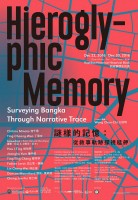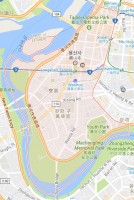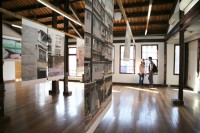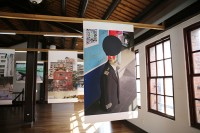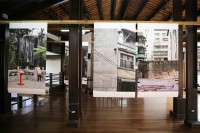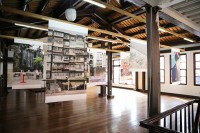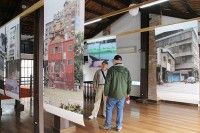Bangka:
Public Space and Imagination
by Wang Chun-Chi
“In 1920, Japanese people restructured administrative regions in Taiwan. Bangka, Dadaocheng, Dalongdon, three districts that used to be directly under Taihoku Prefecture ( هڈ°هŒ—ه»³ ) became Taipei City belonging to the Taihoku State ( هڈ°هŒ—ه· ). That was when the name â€کBangka’ was of cially discarded. Since then, Japanese people called the place that used to be Bangka as â€کWanhua’.â€
This research projects started from the site of Bangka. Typically discussions about space in the city relate to a speci c-temporal framework, which the term â€کsite’ suggests: the special smells, feelings, and reminiscences of memory. Like when we see a building in a city, we can be confused by its current appearance, ignoring
its form in the past or the future. So when I curated the exhibition, the basic idea was to present spatial concepts of the past, the present, and the future. It was by following this abstract idea that I began to integrate some other aesthetic expressions, attempting to represent the spatial and temporal attributes of Bangka’s cultural sites through a variety of displays and performances, as well as interactions with public spaces. Starting from November 22, for a period of four weeks, the artists carried out eld studies at a number of sites in the old blocks’ commercial areas (centered around Wanhua train stations, concentrated and extending from Kangding Road and Dali Street). With a base at such a special urban site as
Bangka’s old city blocks, artists were invited to provide visual and performative presentations in an attempt to evoke and stimulate
all kinds of urban memories and visual imageries. By producing, co-producing, and presenting theirs works, the project has woven together and simultaneously represented echoes of Bangka’s history. Some of the invited artists developed concepts of relativity through a combined practice of installation and performance. This sense of the relative is not only rooted in human interaction but also in the interaction among different forms of cultural context.
The show takes “Hieroglyphic Memory: Surveying Bangka through Narrative Trace†as its subject. Some participating artists are familiar with Bangka whereas others are not. Through
8 different interpretive experiences, they provide re ections on 9 speci c localities through their works, generating rich layers of
multiple cross-sections. The show features nine artists and an
artists’ duo: Ting Chaong-Wen (TW), Cheng Ting-Ting (TW), Hou
I-Ting (TW), Lin Cheng-Wei (TW), Cheng Jen-Pei (TW), Chiriro Minato (JP), Joongho Yum (KR), bأ¶sediva (Elisa Duca and Robin Detje) (DE), Duncan (UK), Fabien Lerat (FR). Additionally, a number of forums will be held in conjunction with the exhibition; scholars from different elds will dialogue with participating artists in the expectation of bringing together members of the audience, scholars and artists in conversation.
interview
Joongho Yum
1.
In your statement before the exhibition you reflect on the fact that Taiwan and Korea have parallel histories of colonization under the Japanese. Do you see similar cultural manifestations of colonization in Taiwan and in Korea?
هœ¨ه±•ه‰چçڑ„ه®£è¨€ن¸ï¼Œن½ وڈگهˆ°هڈ°çپ£ه’Œéں“هœ‹هگŒو¨£ه…·وœ‰و—¥وœ¬و®–و°‘çڑ„و·هڈ²م€‚ن½ وک¯هگ¦هœ¨ه…©هœ°çڑ„و–‡هŒ–è،¨çڈ¾ن¸ï¼Œç™¼çڈ¾é،ن¼¼çڑ„軌è·،ï¼ں
Both Korea and Taiwan have colonial experiences under the rule of Japan. While Korea remains very negative about Japan's colonial management, Taiwan does not seem to react the same way. For the Taiwanese, the Japanese occupation may have produced some positive effects at the time.
Under the same reign, the condition of each colony can be very different. I think that the colonial situation in Taiwan was very difference from that of Korea. Therefore, I don’t know what exactly it was like at the time in Taiwan. But I certainly feel that Taiwanese people have some good feelings about the Japanese colonization. The government seems to be relatively generous to them in the past.
هڈ°çپ£ه’Œéں“هœ‹هœ¨و—¥وœ¬çڑ„çµ±و²»ن¸‹ï¼Œéƒ½وœ‰è¢«و®–و°‘çڑ„經驗م€‚ه„کç®،éں“هœ‹ه°چو–¼و—¥و–¹çڑ„و®–و°‘處çگ†ن؟وŒپè‘—è² é¢çڑ„看و³•ï¼Œهڈ°çپ£ه€’وœ‰ن¸چهگŒçڑ„هڈچو‡‰م€‚ه°چو–¼هڈ°çپ£ن؛؛ن¾†èھھ,و—¥وœ¬çڑ„ن½”é کهڈ¯èƒ½هœ¨ç•¶و™‚產ç”ںن؛†ن¸€ن؛›و£é¢çڑ„و•ˆç›ٹم€‚
هœ¨هگŒو¨£çڑ„و®–و°‘و”؟و¬ٹن¹‹ن¸‹ï¼Œو¯ڈن¸€ه€‹و®–و°‘هœ°çڑ„ç‹€و³پé‚„وک¯وœ‰و‰€ه‡؛ه…¥م€‚وˆ‘وƒ³هڈ°çپ£çڑ„و®–و°‘ç‹€و³په’Œéں“هœ‹و‡‰è©²ه¾ˆن¸چن¸€و¨£م€‚ه› 而,وˆ‘ن¸چه¤ھçں¥éپ“هڈ°çپ£ç•¶و™‚وک¯ن½•و™¯و³پم€‚ن½†وˆ‘çڑ„ç¢؛و„ںهڈ—هˆ°هڈ°çپ£ن؛؛ه°چو–¼و—¥وœ¬و®–و°‘وœ‰ن؛›è‰¯ه¥½çڑ„و„ںهڈ—م€‚當و™‚çڑ„و”؟ه؛œه°چن»–ه€‘و‡‰وک¯ç›¸ه°چهڈ‹ه–„م€‚
2.
You’ve also wrote of urban renewal in Seoul and how that city no longer has the kind of old buildings you can find in Bangka. What was your experience of dealing with Bangka? Did it stimulate you in any unexpected ways?
ن½ وڈگهˆ°é¦–爾çڑ„都ه¸‚و›´و–°ن½؟ه¾—當هœ°é›£ن»¥و‰¾هˆ°é،ن¼¼è‰‹ه²¬çڑ„è€پوˆ؟èˆچم€‚ن½ هœ¨è‰‹èˆ؛çڑ„經驗ç‚؛ن½•ï¼ں這و¨£çڑ„經驗وک¯هگ¦çµ¦ن½ ن¸€ن؛›و„ڈه¤–çڑ„و„ںهڈ—ï¼ں
Seoul is changing at a very fast pace. In order to accelerate the modernization of the city, people used to erase their past without second thought. This phenomenon represents a desire for new things. It destroys however people’s life at the same time.
Seoul is being renewed too much. The traces of the past, like those in the Bangka area, are getting harder to be found. I am surprised and excited to see the strange landscapes composed by the elements of its past and the present in the Bangka area. For me, it is a feeling that is hard to express in words.
首爾ن»¥ن¸€ç¨®هچپهˆ†è؟…وچ·çڑ„é€ںه؛¦هœ¨و›´و–°م€‚ç‚؛ن؛†هٹ é€ںçڈ¾ن»£هŒ–çڑ„éپژ程,ن؛؛ه€‘و›¾ن¸چهپ‡و€ç´¢هœ°ه°±وٹ¹هژ»ن؛†éپژه¾€çڑ„ç—•è·،م€‚這و¨£çڑ„çڈ¾è±،è،¨ه‘ˆن؛†ن»–ه€‘ه°چو–°ن؛‹ç‰©çڑ„و¸´وœ›ï¼Œهچ»ن¹ںç ´ه£ن؛†ن؛؛ه€‘當و™‚çڑ„ç”ںو´»م€‚
首爾çڑ„و›´و–°وœ‰ن؛›éپژé م€‚ه¦‚هگŒè‰‹èˆ؛ن¸€èˆ¬çڑ„éپژه¾€è»Œè·،,難ن»¥ه¾©ه°‹م€‚當وˆ‘هœ¨è‰‹èˆ؛看هˆ°و–°èˆٹه…ƒç´ ن؛¤éŒ¯çڑ„ه¥‡ç•°ه¤©éڑ›ç·ڑو™‚,وˆ‘è¦؛ه¾—ه¾ˆé©ڑè¨ن¹ںه¾ˆèˆˆه¥®م€‚é‚£و¨£çڑ„و„ںه‹•ï¼Œè¶…è¶ٹèھ言م€‚
3. In creating your photograph series “Every Day Stranger Bangkaâ€, you sought out everyday scenes, looking for what might be hidden in the ordinary. Can you tell me about the kinds of people you met on your walks?
هœ¨é€™و¬،çڑ„م€Œو—¥ه¸¸é™Œç”ںن؛؛م€چو”ه½±ç³»هˆ—ن¸ï¼Œن½ 試هœ–و–¼ه¹³ه‡،ه¸‚ن؛•ن¸و‰¾ه‡؛ç•°è±،م€‚هڈ¯هگ¦è«‡è«‡هœ¨é€™و¬،çڑ„ه¸‚è،—و•£و¥ن¸éپ‡هˆ°çڑ„ن؛؛ï¼ں
What I want to demonstrate, though the project “Every Day Stranger Bangka", is what I encountered during my strolls in the neighborhood. I did meet some people on the street. But what we had were rather some random talks. And I don't mean to take photos right in their faces. These photos are not portraits of anybody. I search rather the trace of these people. What are shown in this collection are the traces of their life and an order they establish through their daily life. I see the irony and the humor in this order.
These daily details may be considered insignificant and easily disappeared from our memory. However, it is though the reminiscent of something that we inherit our past and a new life can be thus generated.
é€ڈéپژ這و¬،çڑ„م€Œو—¥ه¸¸é™Œç”ںن؛؛م€چ計畫,وˆ‘試هœ–ه‘ˆçڈ¾çڑ„وک¯وˆ‘هœ¨é„°é‡Œو•£و¥ن¸و‰€éپéپ‡çڑ„種種م€‚وˆ‘çڑ„ç¢؛éپ‡هˆ°ن¸€ن؛›ن؛؛,ن½†وˆ‘ه€‘ن¹‹é–“هƒ…وœ‰ن¸€ن؛›éڑ¨و©ںçڑ„談話م€‚وˆ‘ن¹ںو²’و‰“ç®—ه°چè‘—ن»–ه€‘ه°±و‹چ起照片,這ن؛›ç…§ç‰‡ن¸¦ن¸چوک¯ن»»ن½•ن¸€ن؛؛çڑ„è‚–هƒڈم€‚وˆ‘و‰¾ه°‹و±‚çڑ„هڈچ而وک¯é€™ن؛›ن؛؛çڑ„ç—•è·،م€‚這و¬،çڑ„ç³»هˆ—ه±•ç¤؛çڑ„وک¯ن»–ه€‘çڑ„ç”ںو´»è»Œè·،ن»¥هڈٹ藉由ن»–ه€‘çڑ„و¯ڈو—¥ç”ںو´»و‰€ه»؛ç«‹çڑ„ن¸€ç¨®ç§©ه؛ڈم€‚وˆ‘هœ¨é€™و¨£çڑ„秩ه؛ڈن¸çœ‹è¦‹ن؛†è«·هˆ؛ه’Œه¹½é»کçڑ„ه…ƒç´ م€‚
這ن؛›و—¥ه¸¸ç´°ç¯€وˆ–許ه¸¸è¢«ه؟½ç•¥وˆ–輕وک“被éپ؛ه؟ک,ن½†ه°±وک¯هœ¨é€™ن؛›و®کè·،ن¸ï¼Œوˆ‘ه€‘و‰؟襲ن؛†éپژه¾€ï¼Œن¸¦ç”±و–°ç”ںم€‚
4. Your method of taking photographs that lack a depth-of-field has the effect of turning the images into flattened, abstract landscapes. What are you trying to create with this effect?
藉由ç„،و™¯و·±و”ه½±ï¼Œن½ çڑ„照片è®ٹه¾—ه¹³é¢هŒ–而وœ‰ç¨®è؟‘ن¼¼وٹ½è±،風و™¯çڑ„و•ˆوœم€‚é€ڈéپژ這و¨£çڑ„و‰‹و³•ï¼Œن½ 試هœ–è،¨éپ”ن»€é؛¼و¦‚ه؟µï¼ں
The photography that I am doing is neither documentary nor journalistic. It is not staged photography, either. These are “dry pictures†in which I try not to show any emotion. I am not sure if they look like abstract landscapes. But I do think that an image cannot represent the reality of a thing. Photography is a fiction. This is the character of an image.
I often try to play beyond the rules. I am against to what we call “good photosâ€. As an artist, I hope that my works can convey a meaning different from what other photographers would do.
وˆ‘و‰€ه¾ن؛‹çڑ„و—¢ن¸چوک¯ç´€éŒ„ه¼ڈو”ه½±ï¼Œن؛¦éو–°èپو”هƒڈم€‚當然,ن¹ںن¸چوک¯هٹ‡ه ´ه¼ڈو”ه½±م€‚وˆ‘試著ç›،é‡ڈن¸چè¦پهœ¨ç…§ç‰‡ن¸ه‚³éپن»»ن½•وƒ…緒,而ن½؟ه…¶وˆگç‚؛ن¸€ç¨®ه–®ç´”çڑ„م€Œن¹¾ه½±هƒڈم€چم€‚وˆ‘ن¸چç¢؛ه®ڑه®ƒه€‘看起ن¾†وک¯هگ¦هƒڈوٹ½è±،風و™¯ï¼Œن½†وˆ‘ç¢؛ن؟،照片ç„،و³•ه؟ ه¯¦çڑ„ه‚³éپن؛‹ç‰©çڑ„çœںه¯¦ه°چç‹€و…‹م€‚照片هچ³وک¯è™›و§‹م€‚這ه°±وک¯ه½±هƒڈçڑ„特色م€‚
وˆ‘總試著هœ¨è¦ڈه‰‡ن¹‹ه¤–ه‰µن½œï¼Œوˆ‘هڈچه°چé‚£ن؛›ه¤§ه®¶ç¨±ن¹‹ç‚؛م€Œه¥½ç…§ç‰‡م€چçڑ„ه½±هƒڈم€‚è؛«ç‚؛ن¸€ه€‹è—è،“ه®¶ï¼Œوˆ‘ه¸Œوœ›وˆ‘çڑ„ن½œه“پ能ه‚³éپن¸€ن؛›èˆ‡ه…¶ن»–و”ه½±ه¸«ن¸چهگŒçڑ„è¨ٹوپ¯م€‚
